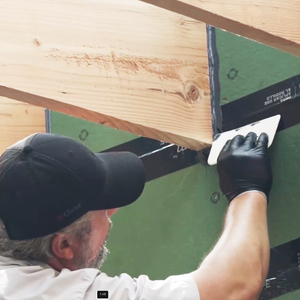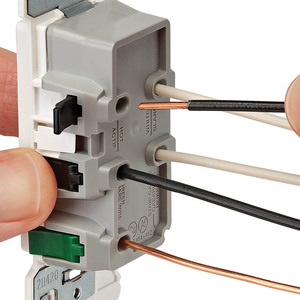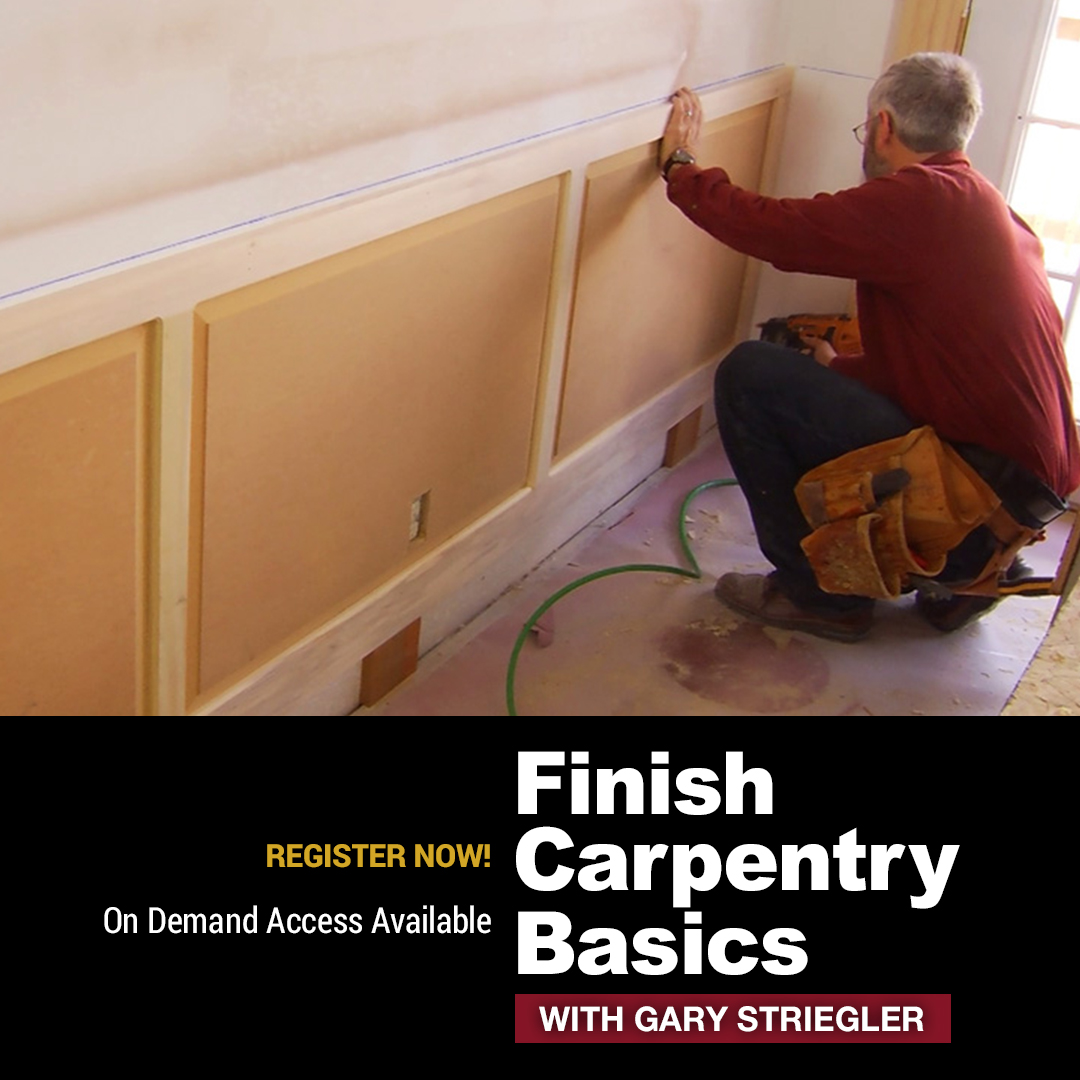If you had a choice of Lam beams or steel what would you use for girders?
Would you use lams for floor joists or 2x material?
I know the benefits of all but was wondering what you all thought. Personally I like the lam beams for girders cause you can nail into them and they’re lighter. I like lams for floor joists cause they’re more stable and no need to crown em’.
I’ve neverrrrrrrrr used a lam beam before and would like to, which is why I’m posting this. I like the idea of them.
Whatcha think?
Be well
Namaste
Andy
It’s not who’s right, it’s who’s left ~ http://CLIFFORDRENOVATIONS.COM


















Replies
I like wood beams better. Easier to work with, and easier to field cut to fit. Easy to nail to and all that.
Ther are contractors who absolutely swear by steel beams, and they do have a couple of advantages. They're generally not as tall over the same spans. And they don't warp like LVLs can.
When you talk about "lams for floor joists", I assume you mean I-joists? I'm not personally sold on them, but they're awfully popular. I've heard estimates that 50% of the houses in this area use I-joists.
I wonder if it would be worth starting a separate thread discussing the advantages and disadvantages of the different floor framing choices available? Lotsa ground to cover. I can start one if ya like - Make it part of the "Board of Directors thingy that was proposed once.
Q: Why are New Yorkers always depressed?
A: The light at the end of their tunnel is New Jersey.
Bossman
I thought that WAS what this thread I started was about. LVL's vs steel.
I like Jimmy Blodgetts response. I asked my arch to put lams and I-joists in the plans where ever she could. Reason? I like wood where I can nail and cut and the stability factor. Weight is also an issue with a small crew vs. steel. Will be the first time I've used the stuff but I love the idea.
Oh,and who said that extra 4" is a great idea? Nice response. We all wish....lol
Be ....uhhhh
Namaste'
AndyIt's not who's right, it's who's left ~ http://CLIFFORDRENOVATIONS.COM
"I thought that WAS what this thread I started was about. LVL's vs steel."
I guess I was thinking about a thread discussing the alternative floor framing methods - I-joists vs. 2X lumber vs. the obvious choice - Wood webbed floor trusses.
I think I could present a completely unbiased comparison.............(-:You can call me anything you want, as long as you don't call me late for dinner.
Bossman
How'd I know you'd be the biggest poster in this thread? Seems we're family by now. Know more bout you then my next door neighbors.......lol. Think I can get a discount from you for LVL's sent to NY LI?.....Nahhhhh
Be well bro
Namaste
AndyIt's not who's right, it's who's left ~ http://CLIFFORDRENOVATIONS.COM
"Biggest poster", huh ?
You know, that could be taken more ways than one....................(-:After all these years, I see that I was mistaken about Eve in the beginning; it is better to live outside the Garden with her than inside it without her. [Mark Twain]
"Biggest poster", huh ?
Bossmiester
Depends if you use Ragner's equation...lol
Be in a well
Namaste
andyIt's not who's right, it's who's left ~ http://CLIFFORDRENOVATIONS.COM
"...Ragner's equation..."
What'd he say????
Brinkmann for president in '04
The only time I have used LVL's as joists was in a renovation where we needed more ceiling height. Incidently we also used a steel beam as the a primary structural member to cut the joist span in half. Then we installed the LVL joists. Much more expensive in material costs but the 4" gained in ceiling hieght was well worrth it. The Client comments that he was able to gain those precious 4" to his friends every chace he gets.
yeah, anyone who gains 4" would be excited about it!
Here I am conflicting with the Boss again, but when I've had to choose between Lam beams and steel, the specified lam beams weren't as deep. In the most recent case, the span was something like 30' and the lam beam was something like 8 1/4" X 22 1/2" and a steel WF beam was spec'd at either 24" or 30"; while I preferred the wood for a lot of reasons, the depth was the deciding factor.
Jules Quaver for President 2004
Steel? I avoid it if I can. I'm sure there are applications where steel works better, but between glulams and bolted together LVL's, seems like we have way more ability to meet long span requirements now than when we first started in the profession.
But then again, I never learned to weld or use torches very well. I just like working with stuff I can cut, shave, and nail, I guess.
If you ARE asking about I-joists for joists, I love them and use them every chance I get. Really, really like them for rafters, too. Had to learn how to frame overhangs a little differently, but it sure is nice dealing with light, strong, straight stock that I know won't split. I'd have to say, I-joists are one of the best innovations I've seen over the past 30 years (right up there with pneumatic nailers, architectural comp roofing and fiber cement siding).
If you are considering built up LVL beams, glulams are still a little cheaper here in the Pacific Northwest, and we can get them with 0 crown nowdays, too. Love glulams.
Brinkmann for president in '04
Yo notchman -
I wasn't thinking about really long spans. I was thinking of the more typical 10 or 12' span between posts that I see around here.
In that case, I would most likely be looking at a 11 7/8" LVL versus an 8 or 10" steel beam. You can always tell a Harvard man, but you can't tell him much.
On a related note, how does the deflection of a lam beam compare to that of steel, for the same span, beam depth and load? The reason I ask is that I'm considering removing the only column under a short beam in the basement, and in order to retain the same max deflection at the mid-span as is now between column and wall would require a substantial WT added to the bottom of the steel. Deflection governs in this case, and replacement with a gluelam may be an option. Not trying to hijack, it's just that deflection is a major consideration too, and is certainly relevant to this discussion.
Be seeing you...
I would think there's no question that a steel beam would have less deflection at the same depth as an LVL.
But it's not really that simple. I prefer to take beams on a case by case basis, and try to figure out what the best solution is for that particular situation. For two people in a marriage to live together day after day is unquestionably the one miracle the Vatican has overlooked. [Bill Cosby]
TDKPE,
The short answer to your question is that a #1 Doug fir beam would deflect 16x more (29/1.8) than a structural steel beam. This assumes identical loading and identical size and shape of the two beams.
To give you a more detailed explanation, the general equation for deflection (for a uniformly loaded, simply supported beam) is:
deflection = (5*w*L^4)/(384*E*I)
Where:
deflection is the maximum deflection in inches (which occurs at midspan)
w is loading in pounds per lineal inch
L is span in inches
E is modulus of elasticity in psi
and I is the moment of inertia in units of inches^4
"I" is purely a function of the size and shape of the beam's cross-section, so if you assumed that you'd be using the same sized beam (whether steel or wood), the only variable remaining would be E.
For structural steel, E is about 29,000,000 psi, whereas the value for #1 Doug fir is about 1,800,000 psi.
Hope you're still awake! ;)
Ragnar
Edited 12/5/2002 5:52:56 PM ET by ragnar
This is my first reply so I hope I do it properly. I f not, some direction would be appreciated.
For straight forward applications, such as floors with simple opennings, I would only use I's if the span was greater than 2x material could handle. If the floor system was complex, ie, had more than one openning or cantilevers or doubles or whatever, I would do my darndest to avoid I's (add an extra beamor go 12" oc) because of the fiddling around necessary to double them, hang them and, depending on the type of I, cut them. (Think 45 degree cuts through a 2 1/2" flange). My experience with all the web reinforcement at bearing walls and joist hangers was frustrating and time consuming. Further, they came to this particular site with at least as a significant crown as the average lift of 2x10's, not to mention some mould in the O.S.B. web from exposure to moisture. You also need to pay extra $ for appropriate hardware. Granted, our local supplier will do a free take-off of all bits and pieces including prefab web siffeners but things change occasionally on site and you may be left running around after all.
I have also had the distinct displeasure of framing a slightly complex roof with I's and it was awful. I figure that an apprentice spent almost 3 days solely dealing with web stiffeners at overhangs and doublers. Never again! And this roof only had shed dormers and extra large overhangs. If there had been valleys or hips it would have been a nightmare. If it is unavoidable, at least I will know to add some extra time.
They are light, get good vent on top with increased depth and can go a long way but aren't the be all and end all the industry would like to think.
I also like wood beams, engineered or built-up, because of flexibility in site cuts, attaching and superior fire resistance to steel. They are also stiffer torsionally and there is something to be said for the mass of a wood beam. Is that just emotion or is there some science behind that feel? I'd like to know.
Regards
Ian
To add on to Truehaven's comment about superior fire resistance of wood. That can be true if the beam is on the order of 20cm (8") or better. The wood forms a char that acts as insulation and can give the beam a one hour fire rating if adequately sized. Actually, the beam can be a bit smaller than 8" in width if the depth is sized so that there still will be adequate strength left after it is charred for an hour. There are formulas that can be used to calculate how big the beam has to be.
The advantage of steel is that it is non-flammable, but if the contents of the building combusts and the steel is exposed to the heat of the fire, then the steel starts to lose strength as the temperature increases and it can become a very heavy piece of spagetti. A beam can be boxed with rock, however, to give it fire protection, or sprayed with various types of fire resistant insulating materials (most of them not particularly attractive, however). A typical steel farm building might well collapse in a fire of the contents before a typical wooden barn.
I think someone on one of the fire threads mentioned coating the wood to increase fire resistance. I believe that the "fire resistant" wood coatings are only effective in stopping flame spread and don't really protect the beam or truss from charring and weakening when exposed to the heat of a typical fire.
However (disclaimer follows) it has been a number of years since I was involved with this stuff, so any corrections would be appreciated.
Casey
thanks man.please keep posting cause you have real good information that I appreciate
Be well
Namaste
AndyIt's not who's right, it's who's left ~ http://CLIFFORDRENOVATIONS.COM
I have to replace a center beam in my garage which is made up of 3 2x10's spanning 20 feet. The beam runs perpendicular to 2x12 floor joists which run the entire length of the garage. It is sagging in the middle which is no surprise. The engineer that I hired spec'd a w8x24 steel beam. I called the engineers at US GluLam and I was told that I would need 4 14" LVL's. Just thought I'd throw that out there for a comparison. -Ed
What's the other dimension of the geerage ? 20' by what?
Any roof load on the beam?
What loading did they use for the floor?Mediocrity: It takes a lot less time and most people won't notice the difference until it's too late.
Boss, the garage is 20x22 feet long. The floor joists span 22 feet which run the entire length. No roof or ceiling load. After the engineer spec'd the 8 inch beam I was told by 2 other people that I should go with at least a w10x22 or w10x26. -Ed
I thinkyou're on tne money as far as fire protecting a steel beam. That all takes time and $, though not a lot. If one wanted to be quick and dirty you could drywall right onto a parallam to increase it's fire resistance, as opposed to furring a steel beam. Again, not talking a lot but some $ difference.
Keep in mind..for a floor system..that and engineered system....using I joists....is best when kep as a complete engineered system....as in...I joists are made to work with engineered band boards. Engineered wood products expand/contract different the dimetional lumber...so the standard 2x whatever should be replaced with a lam something or other for the box/band boards to gain all the bennies of the I-joists.
as far as steel vs lam or built up wood...ya gotta see what the numbers call for...and where the beam's to go in the first place.
An exposed basement beam with floor joists laying on top may as well be steel. A hidden retrofit beam in a first floor ceiling..that is to hold up the second floor joists..that'll hold up the third floor...is also just as easy to slid in steel...if it'll fit between the ceiling and the floor....notch some joistsand/or weld on some hangers and away ya go......
All depends what ya need....and usually revolves around the access to the beam for attaching the other stuff.
For a new addition where a bunch of new floor joists are gonna attach.....a built up wood or lam/engineered beam of some sort can make for quick attaching of the hangers and corresponding joists....
All depends.
I joists are great where the span is big..but ya botta block and such.....
JeffBuck Construction Pittsburgh,PA
Fine Carpentery.....While U Waite
Ian
I appreciate your comments. Just a gut feeling is I plan on using 2X's for joists and headers and going to try LVL's for beams instead of steel this time. Just is a gut feeling as a builder for almost 30 years. As far as fire goes....the Bear and me spoke about that in detail this evening on the phone and I think what I concluded from the conversation was that LVL's are made with glue which I "think" is flamable but not sure to be honest. Either way I think LVL's are flamable none the less.........once again.....I'm not sure but believe so. There sure are lots of flamable products in the development of a home so......This is sure open for discussion. Night.
Be a wall
Namaste'
AndyIt's not who's right, it's who's left ~ http://CLIFFORDRENOVATIONS.COM
true
one other thing........hope you post more often. You seem to be very well versed in constuction techniques and we would love you here. thanks
Be well
Namaste
andyIt's not who's right, it's who's left ~ http://CLIFFORDRENOVATIONS.COM